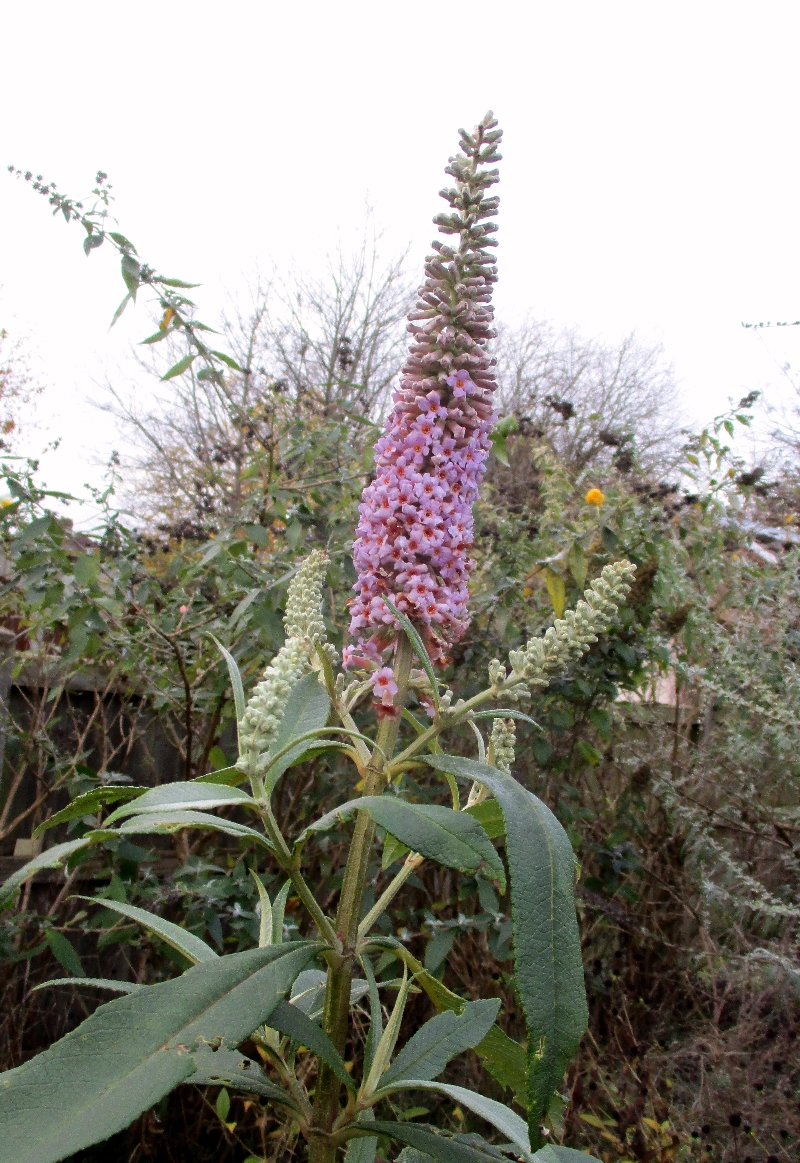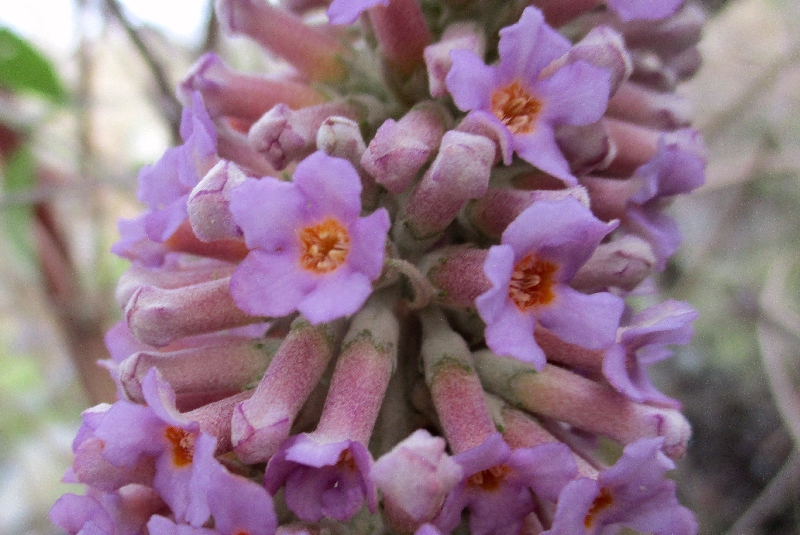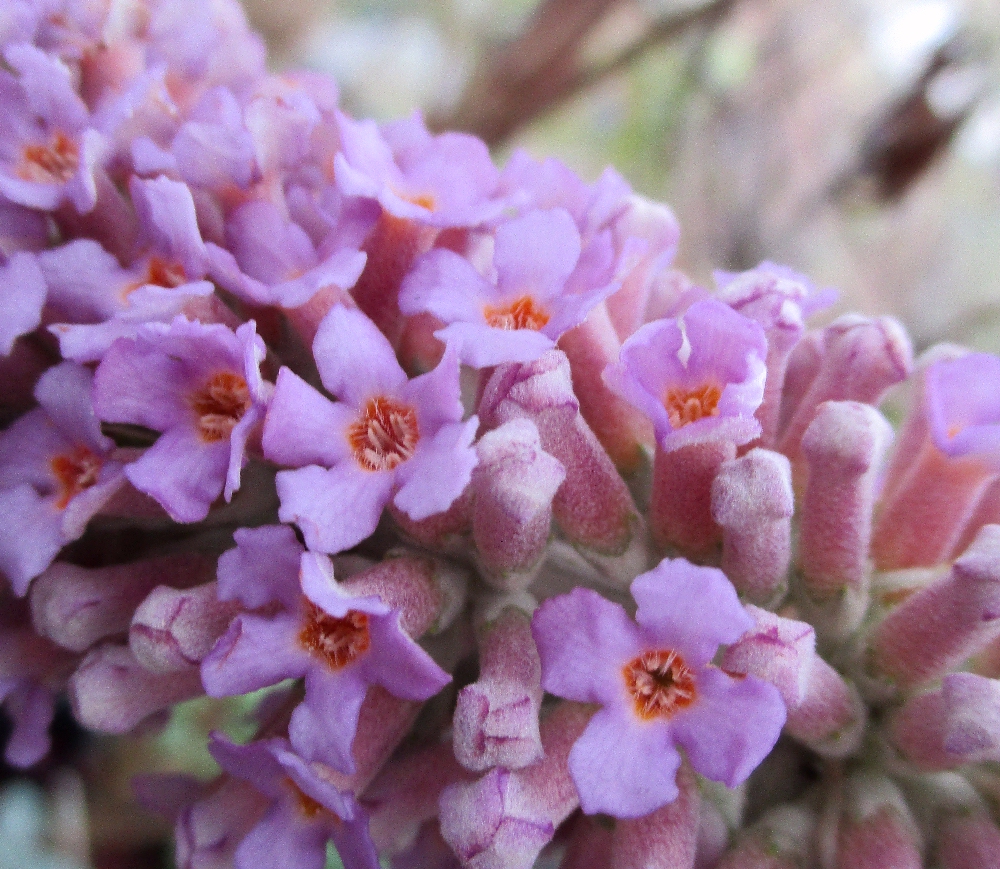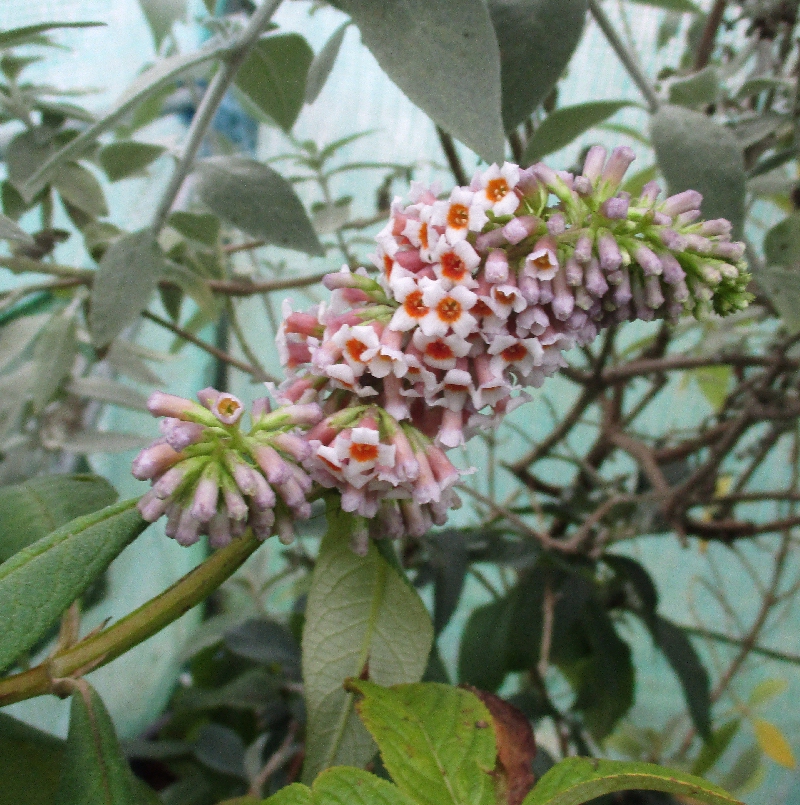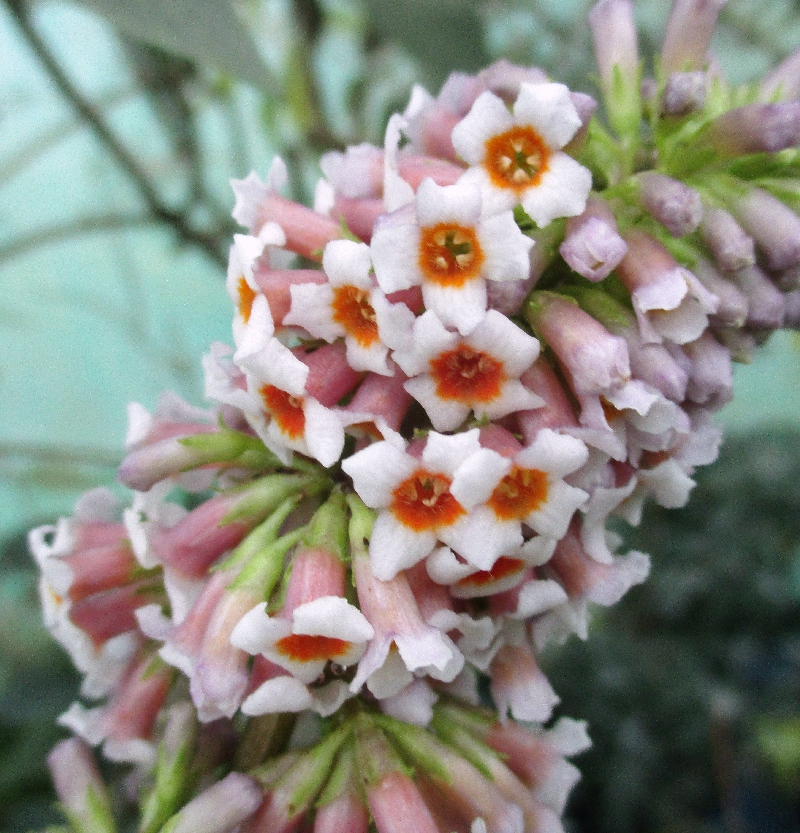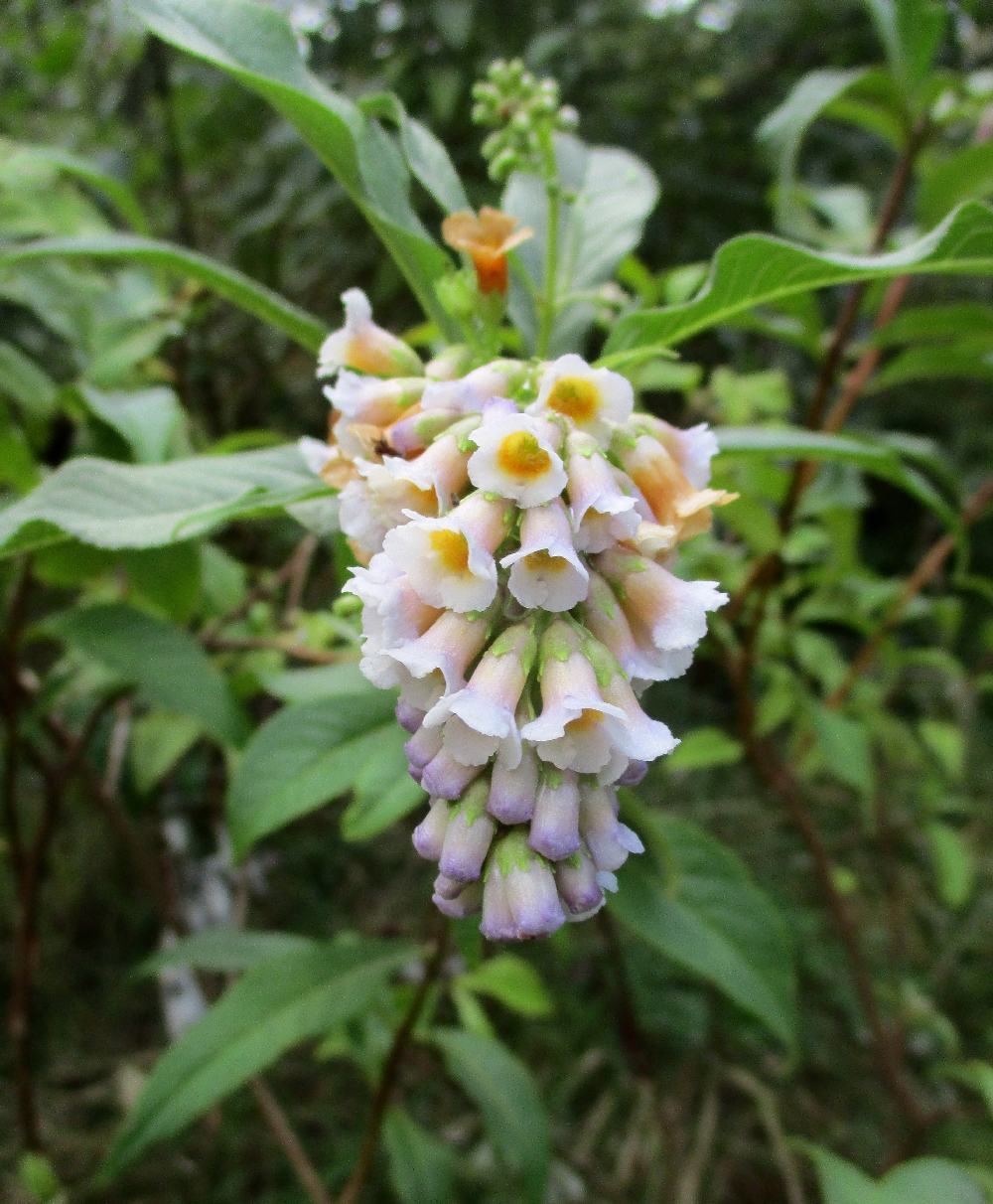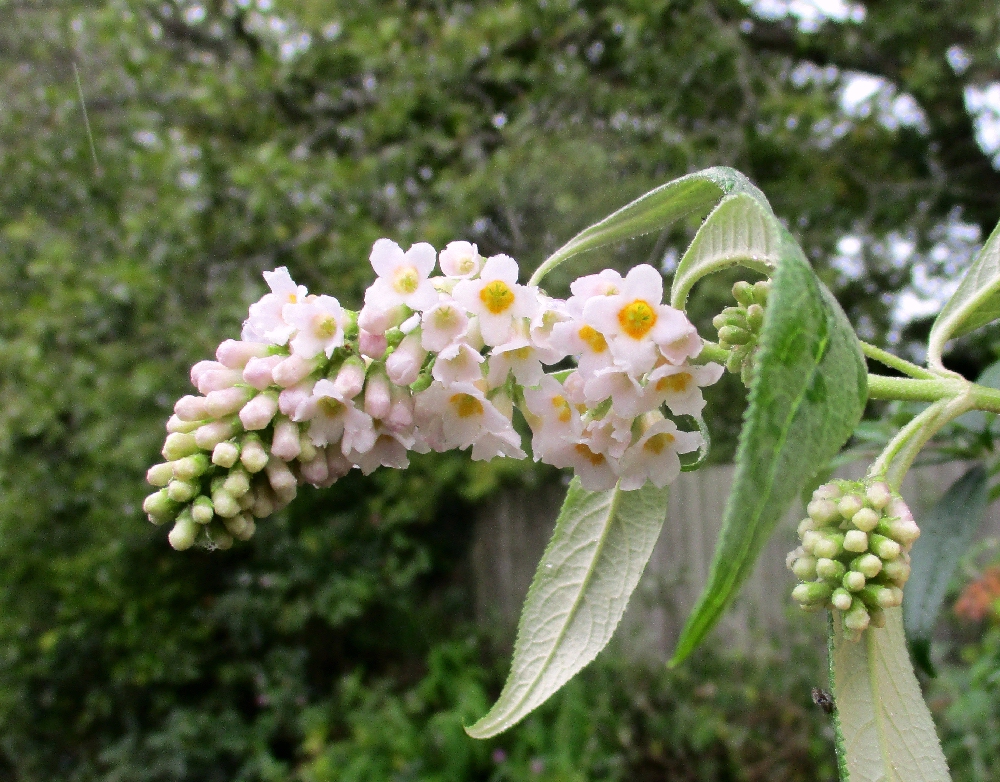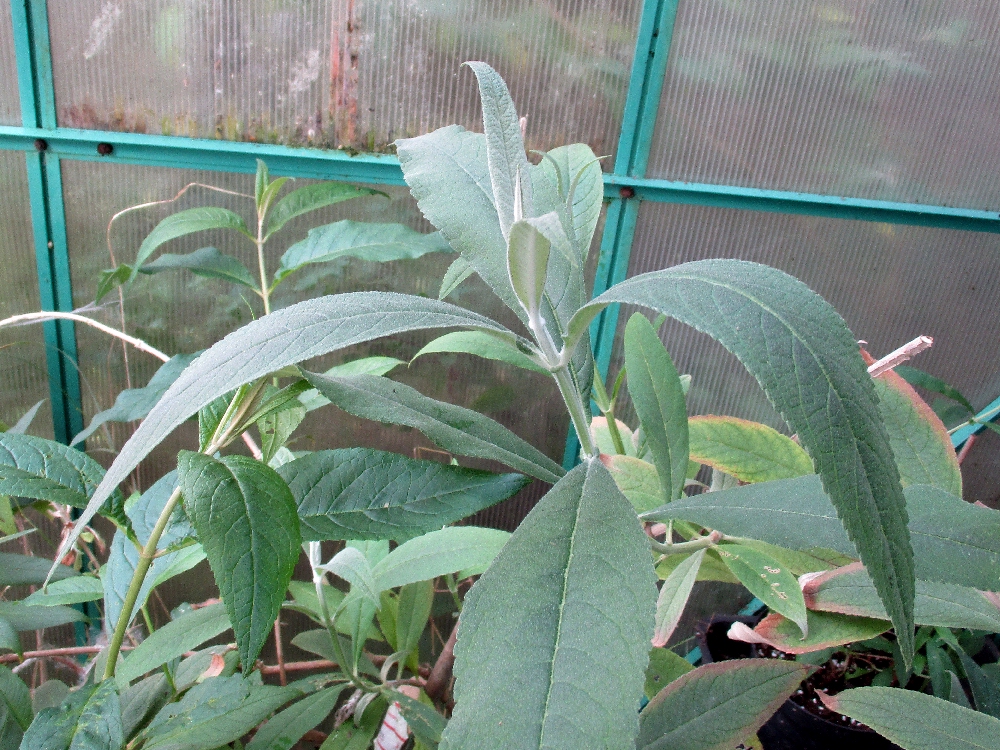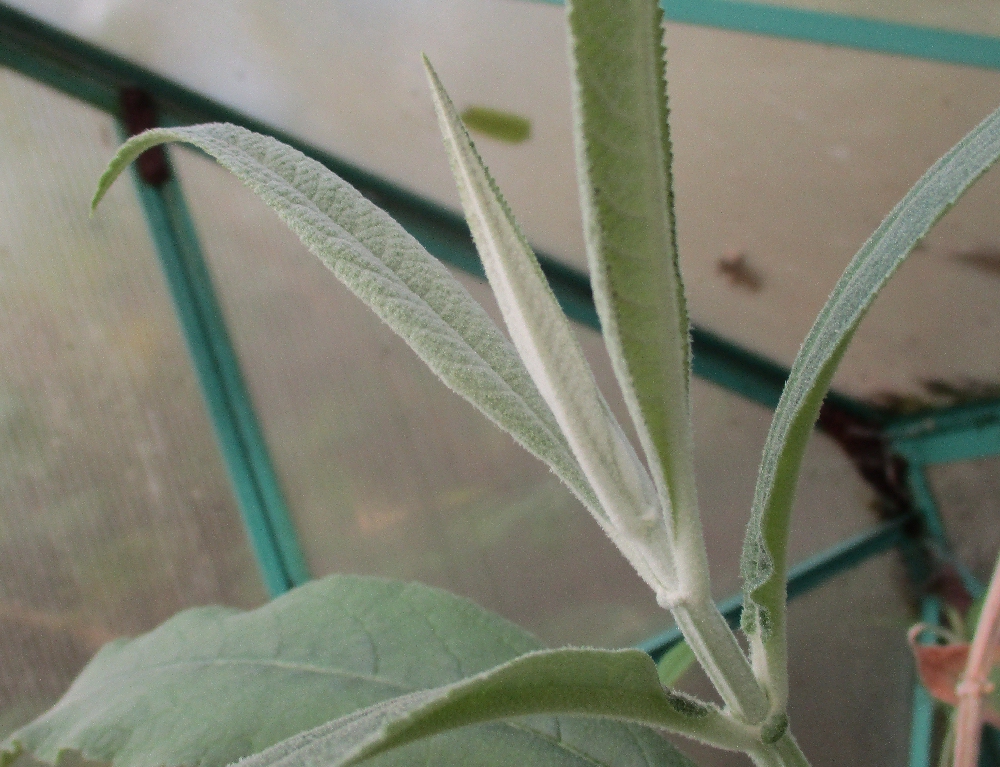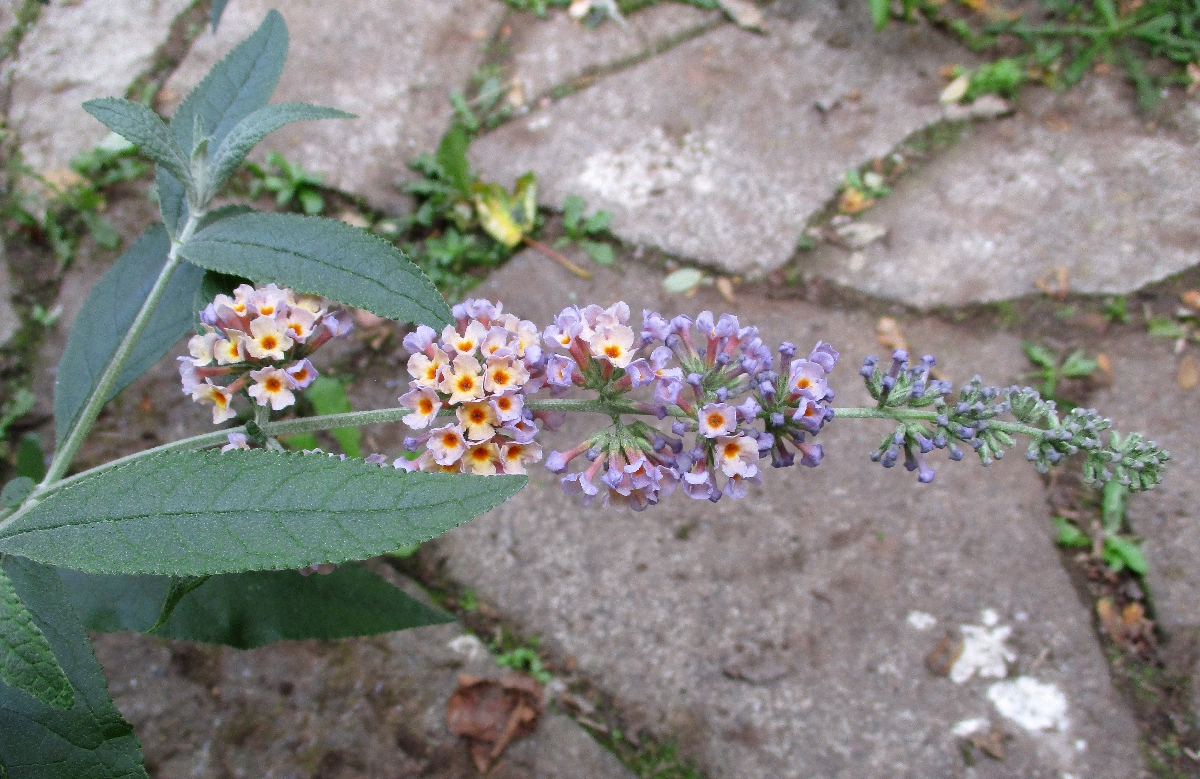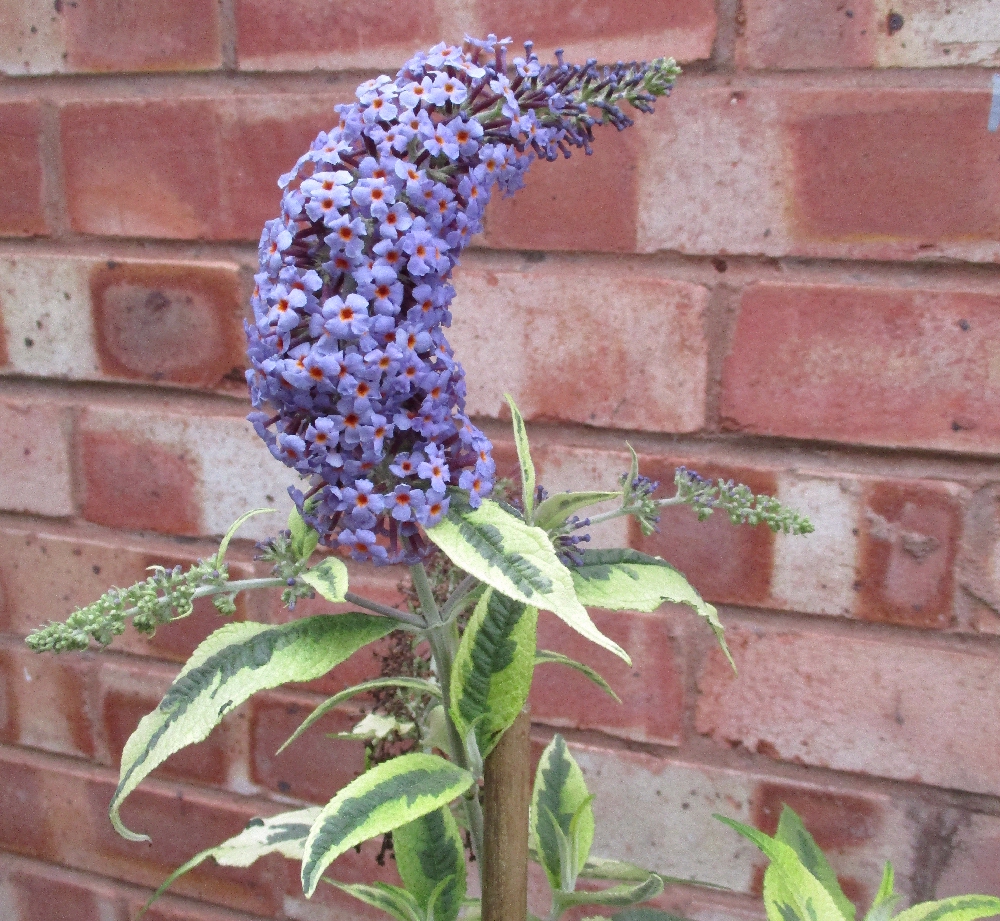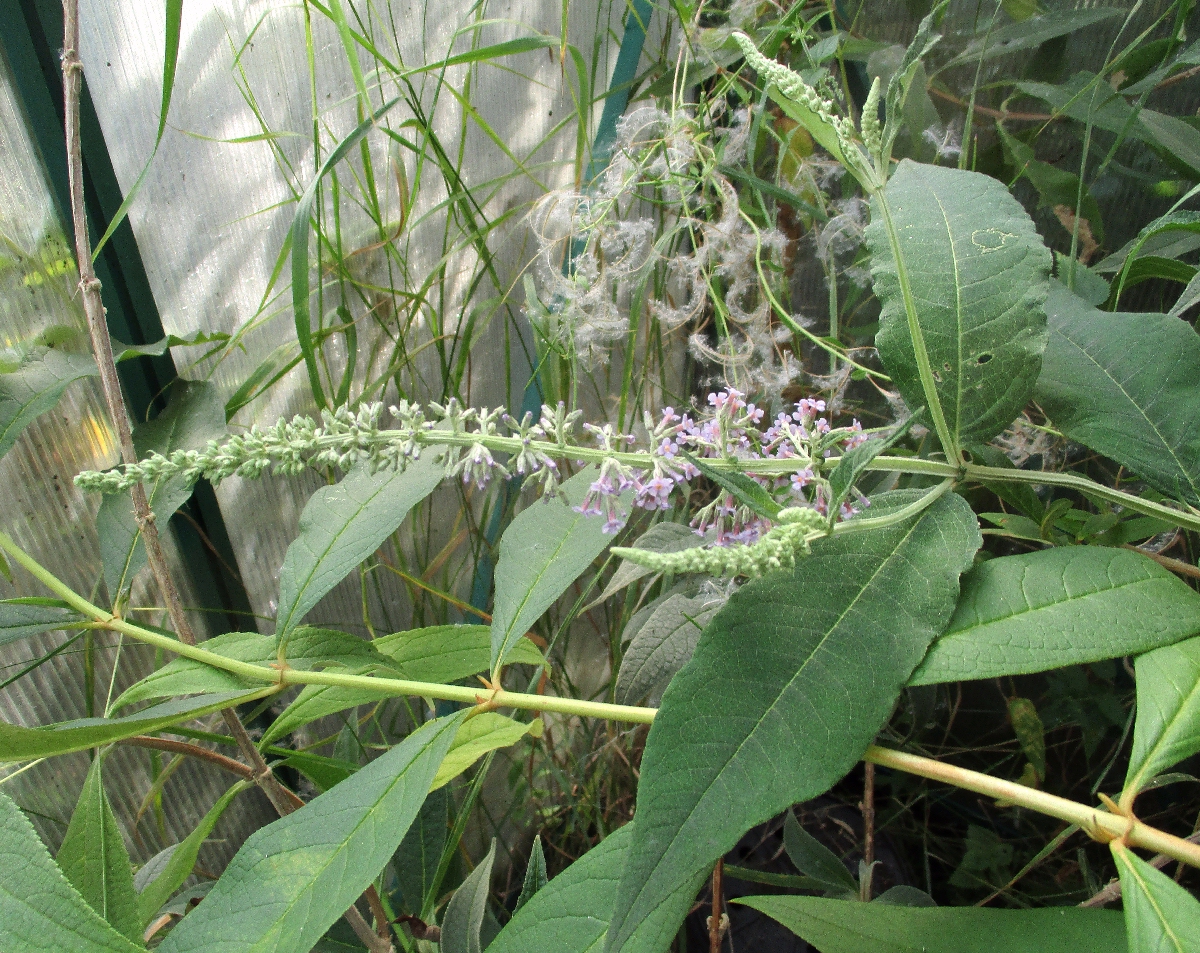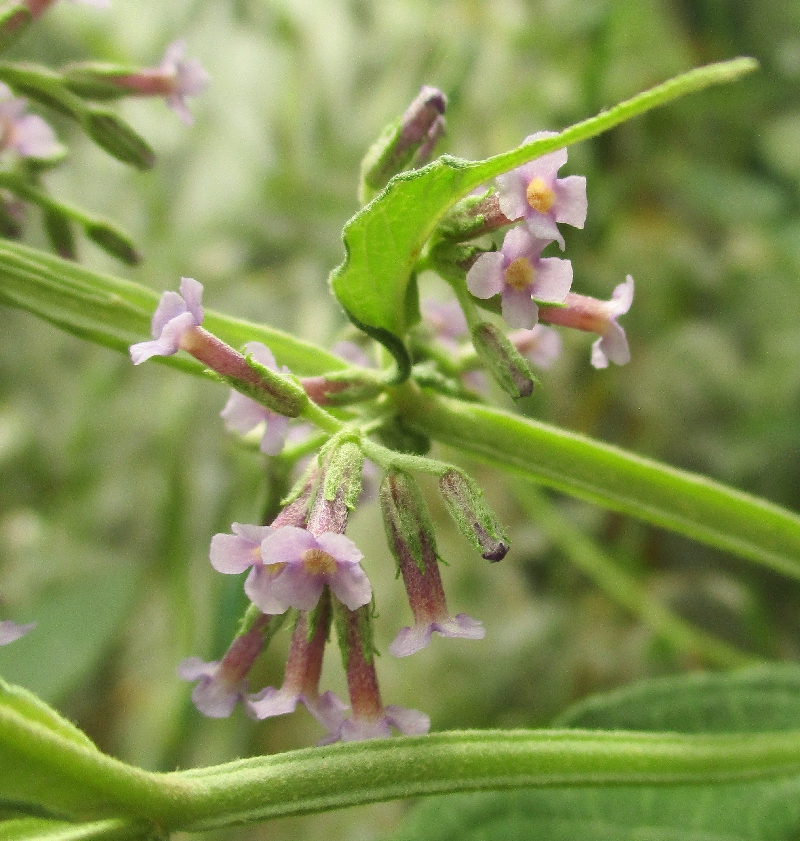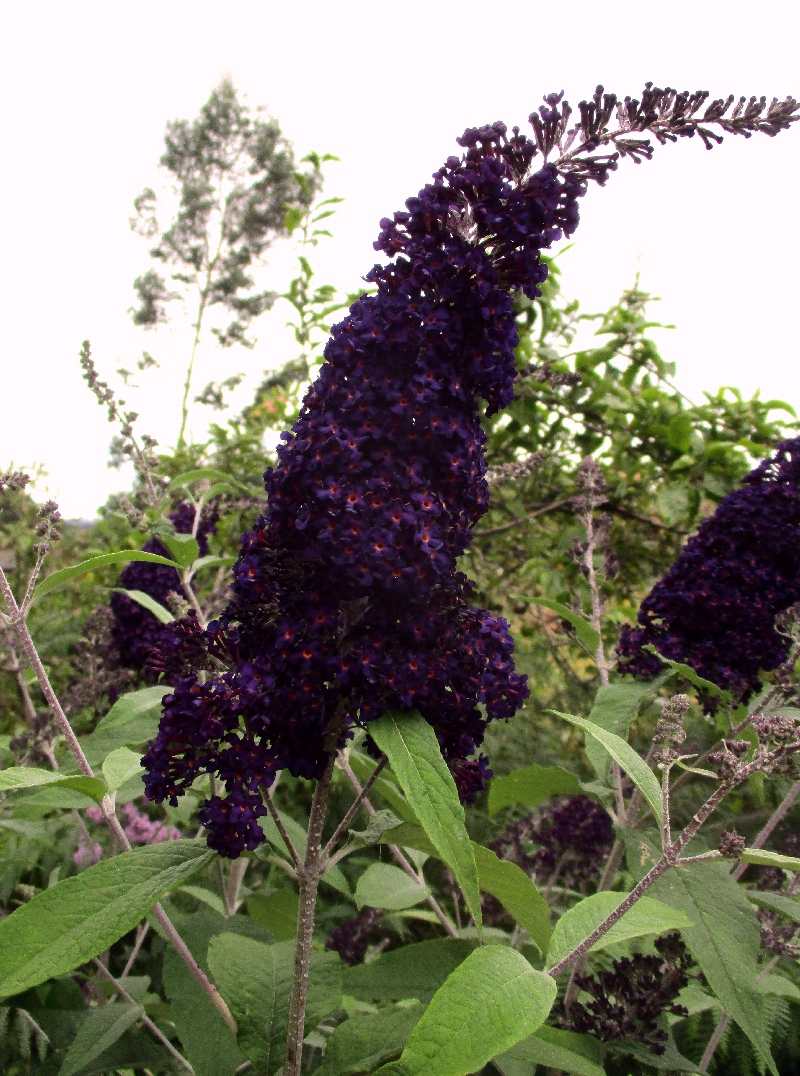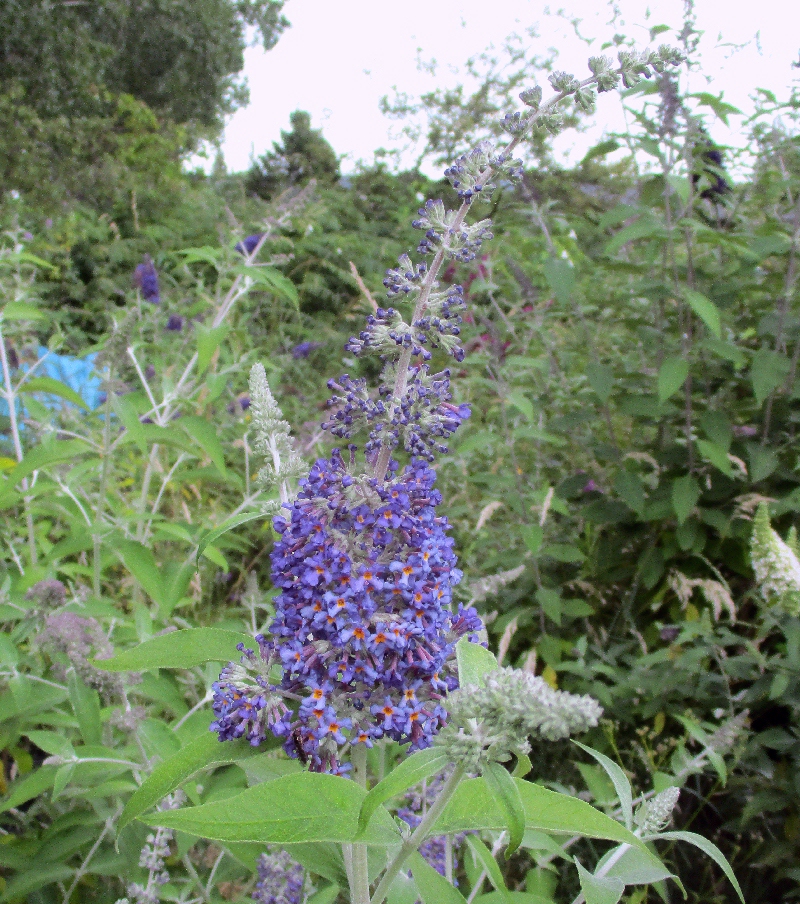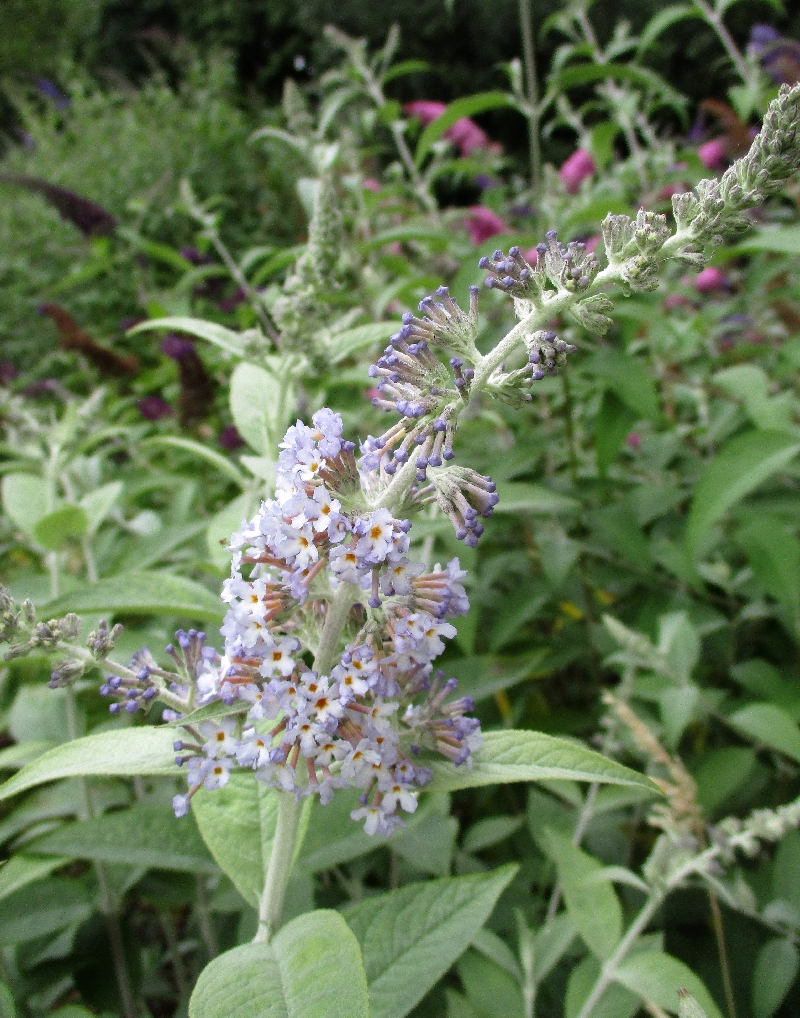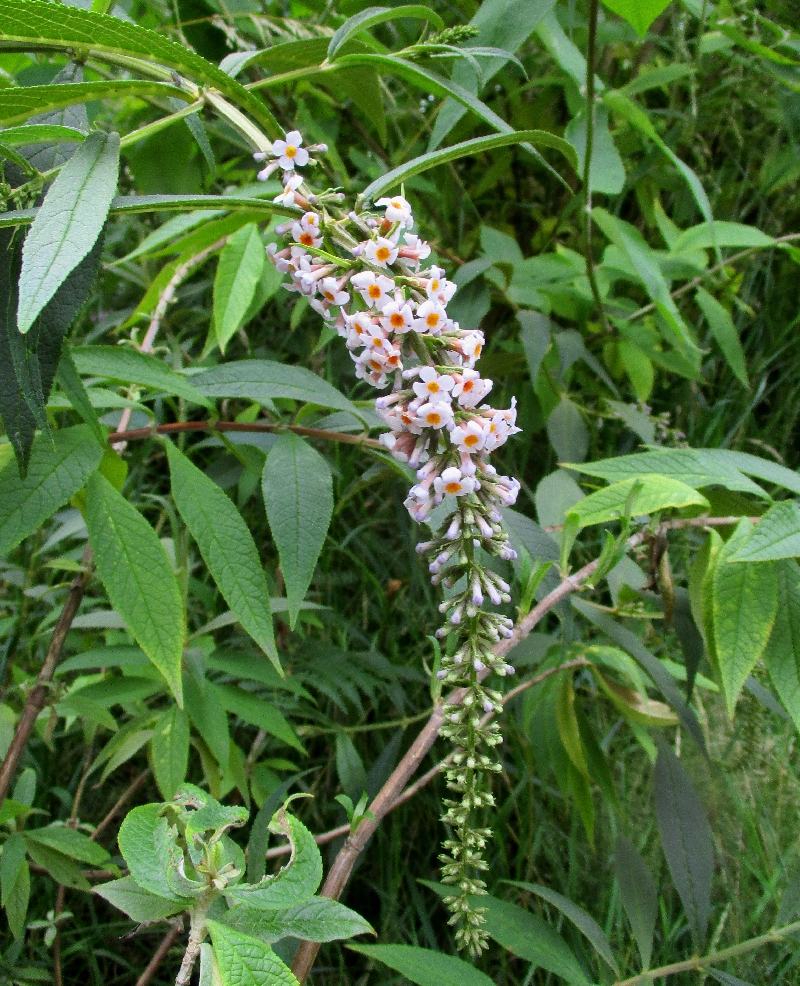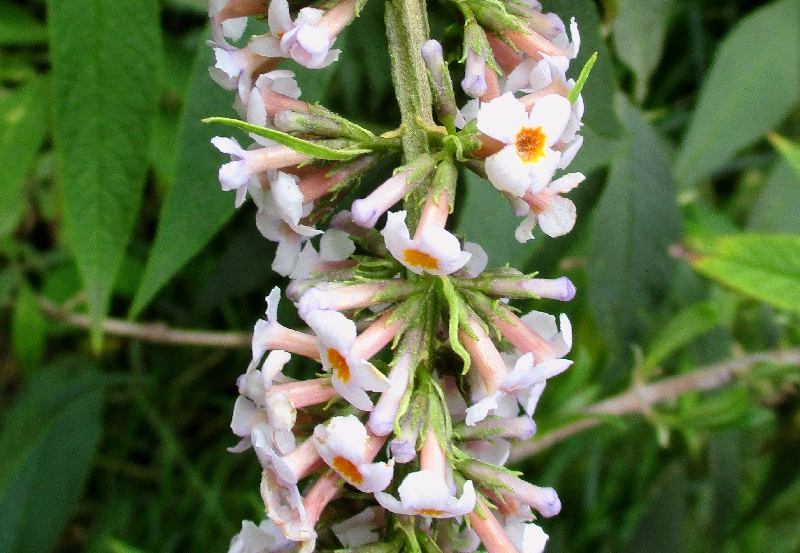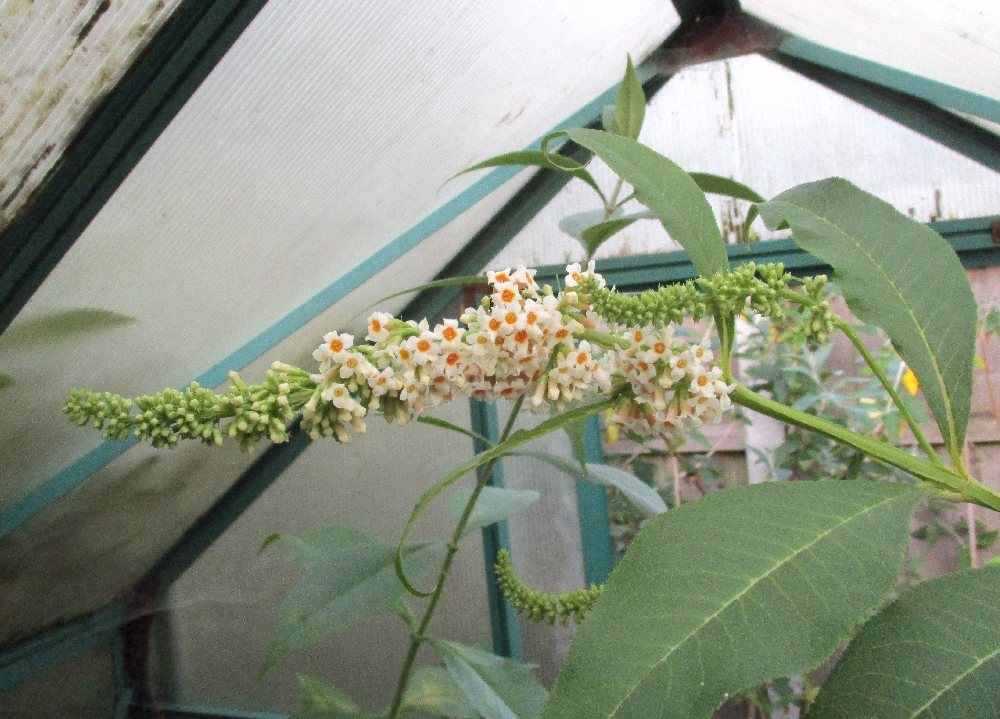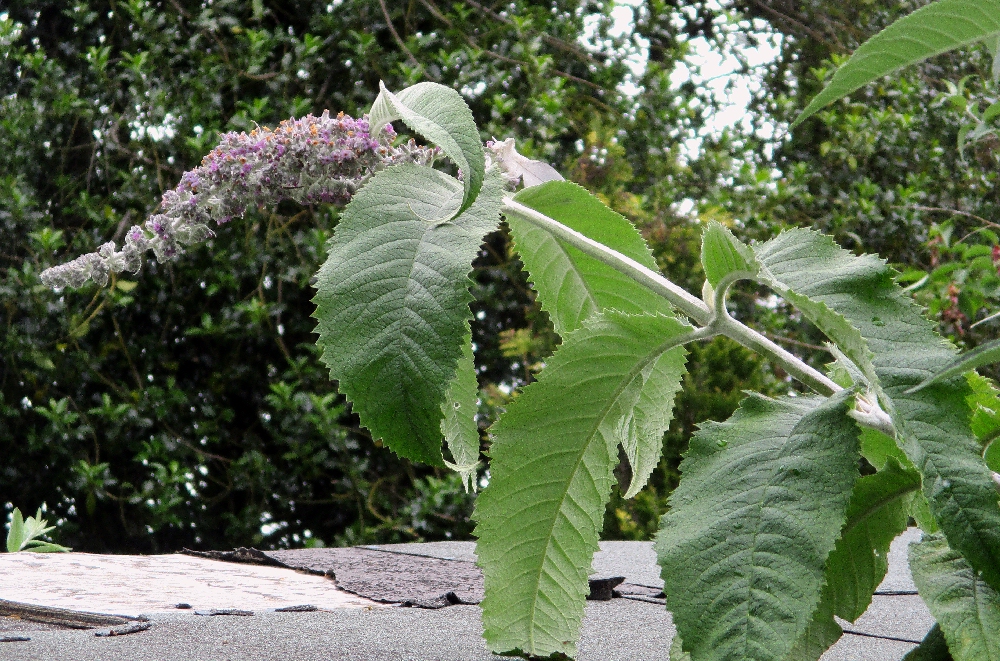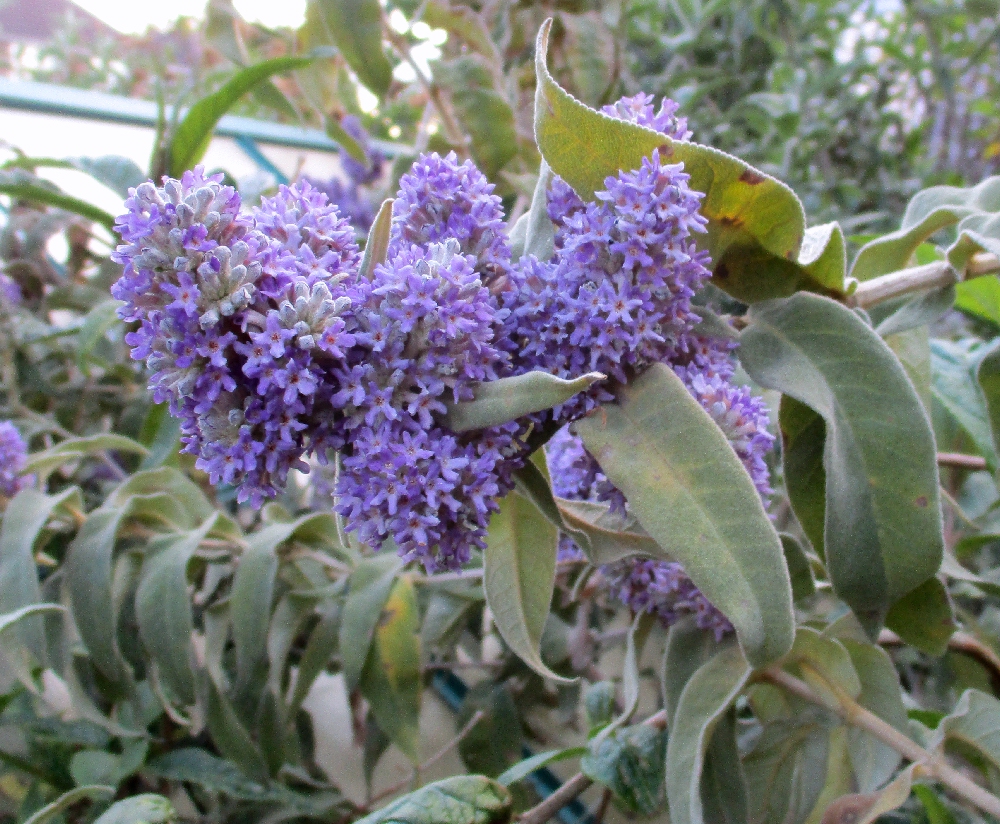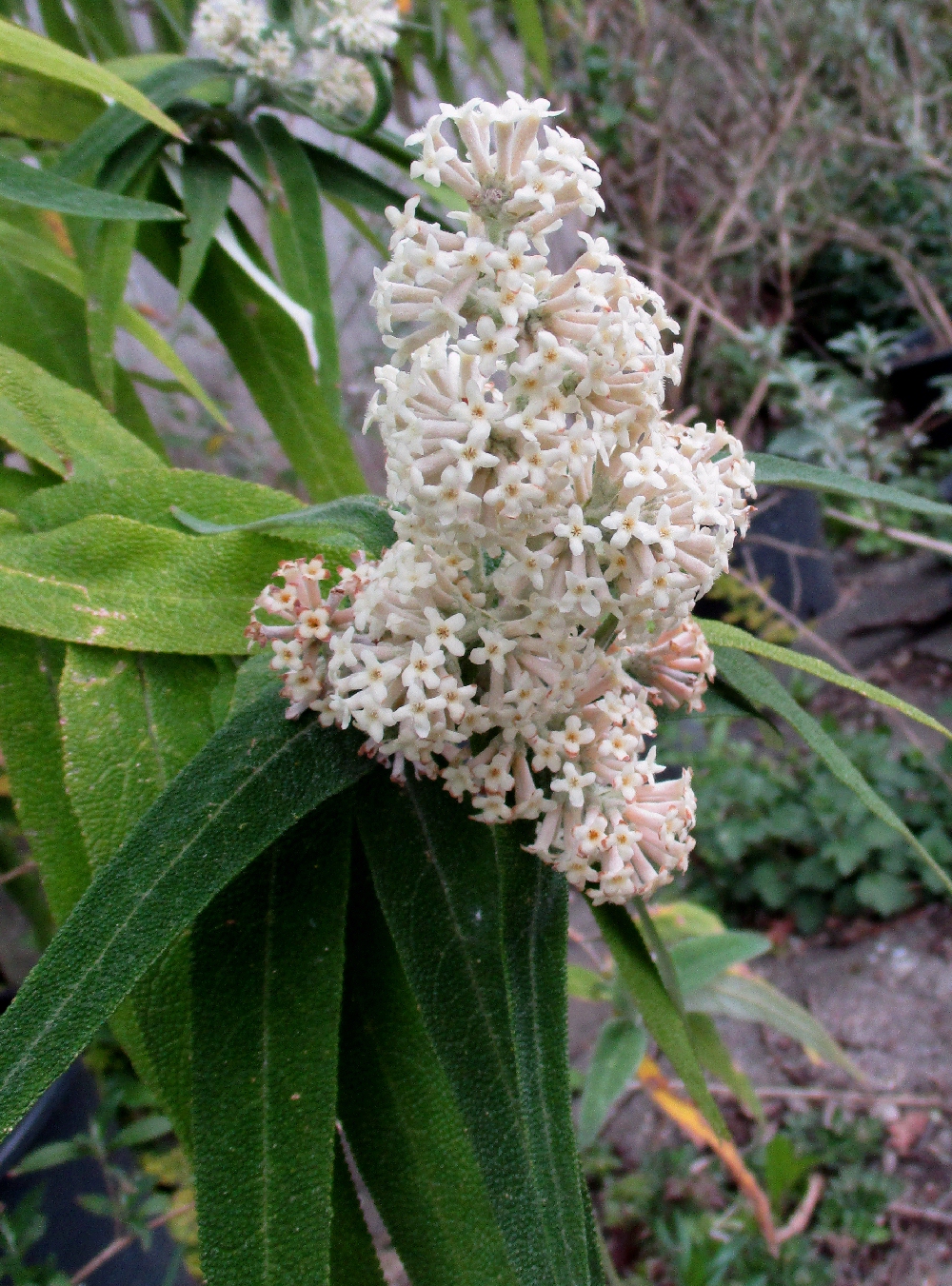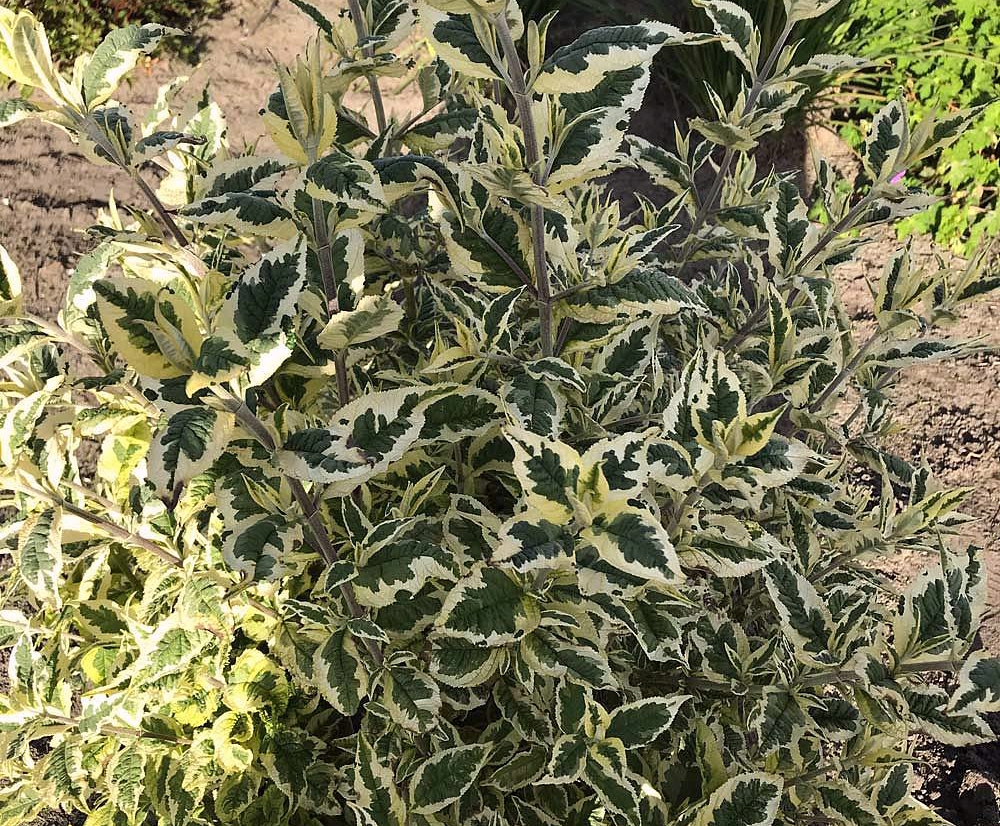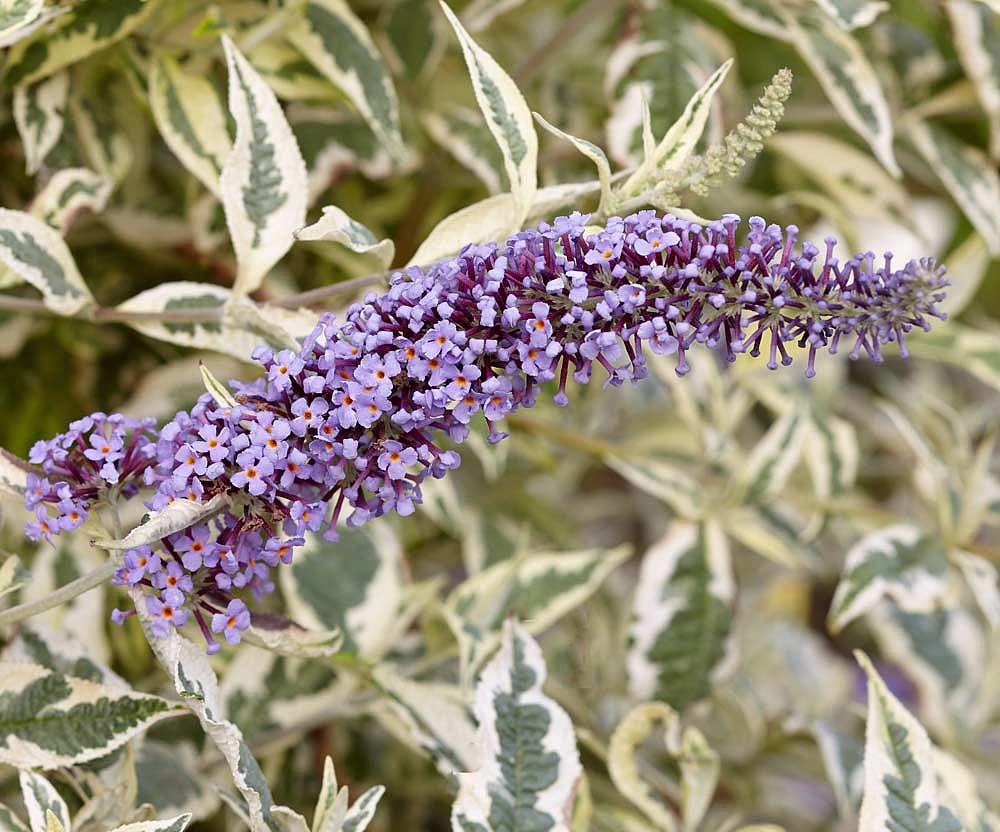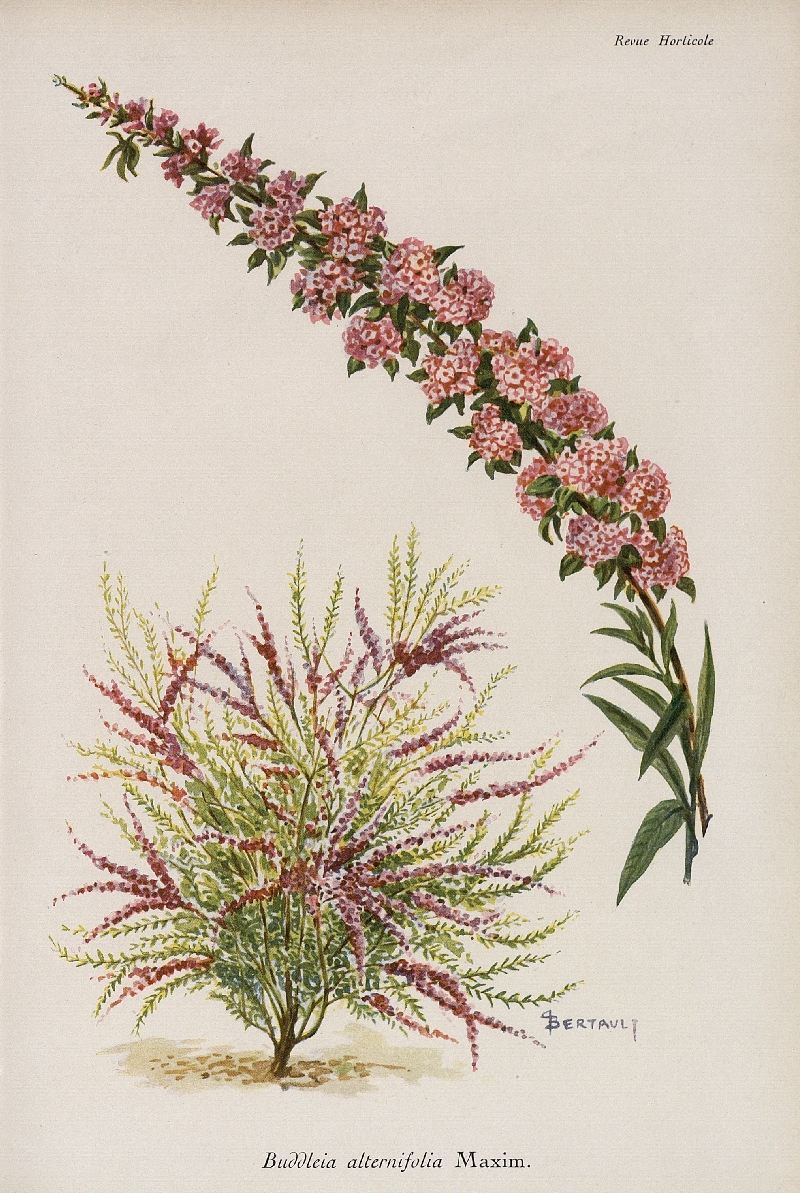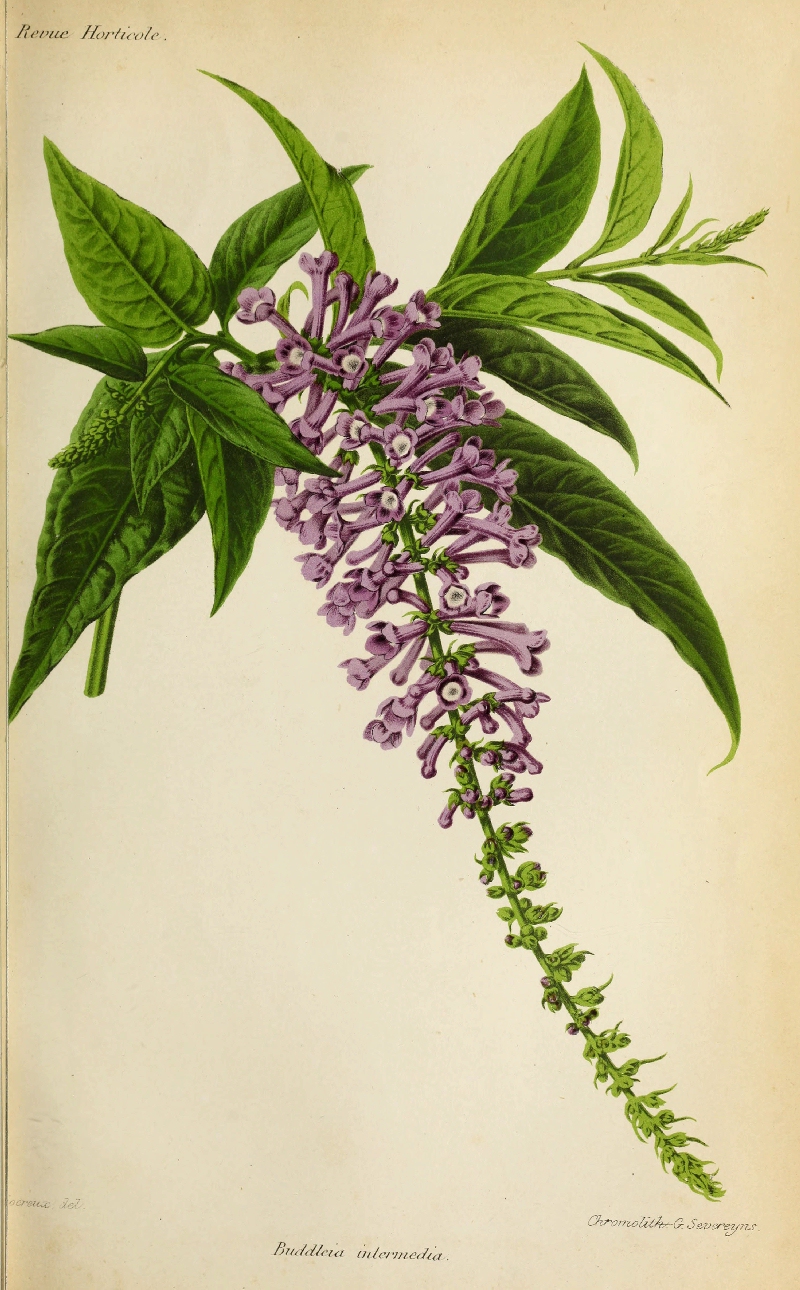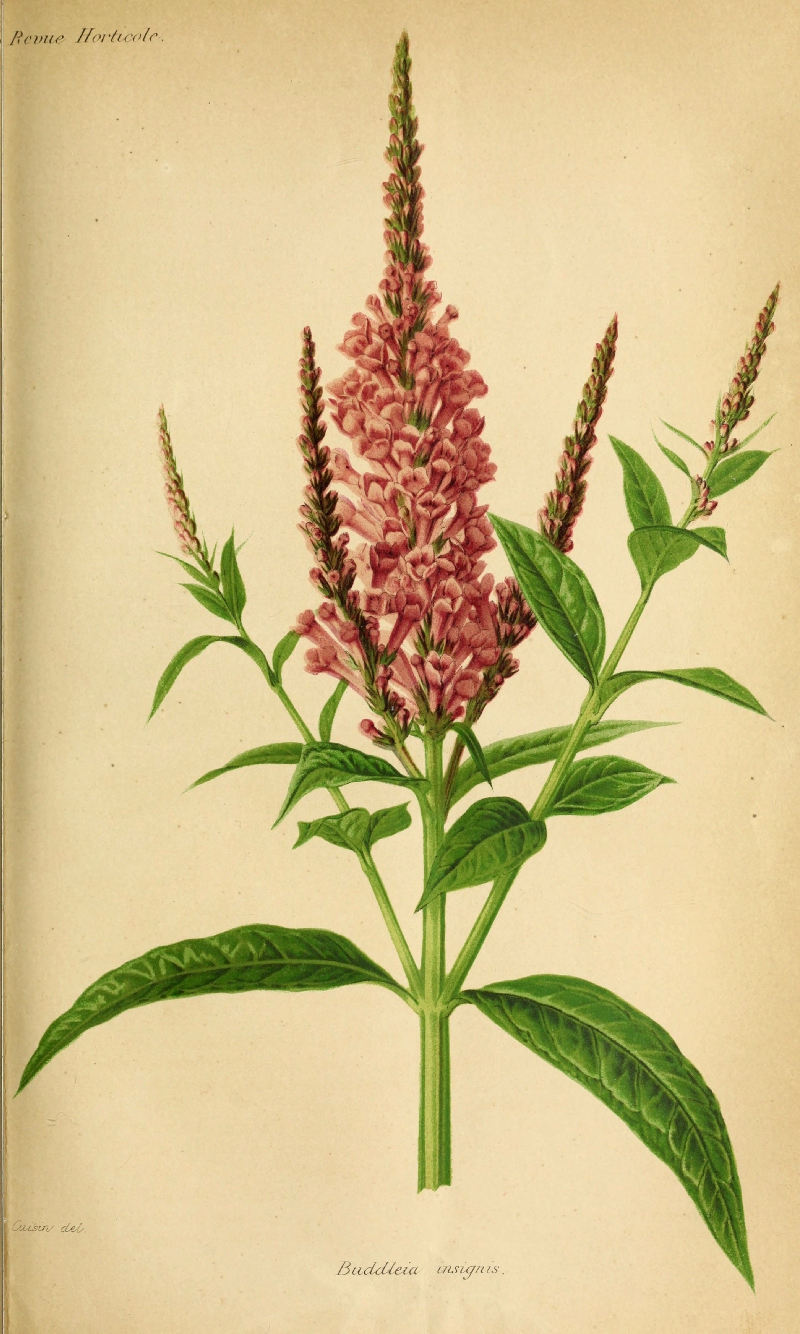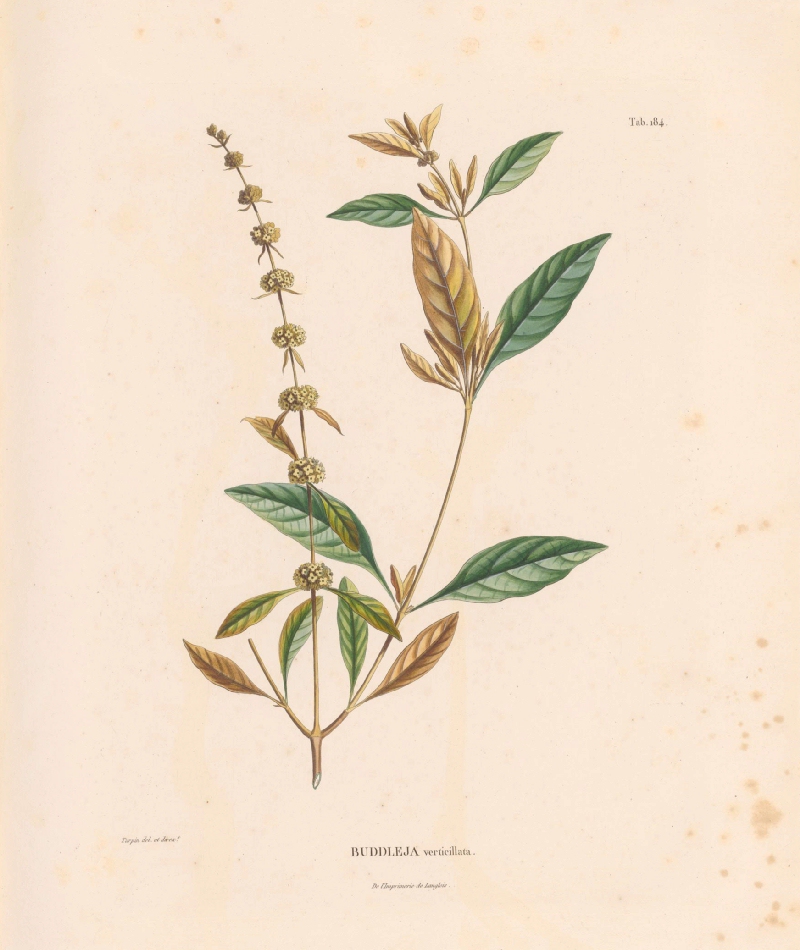
 | |
Click images to enlarge | |
Buddleja macrostachya PAB4198Posted 25th November 2020This species is quite variable, has a wide range across from India to Vietnam, and is possibly still undergoing rapid evolution. With different ploidy levels and phenologies, it might be tempting to split the species into several separate subspecies or even species. Personally, I think all the types of B. macrostachya are in fact one continuous species, with nothing justifying further division into subspecies. This one is PAB4198 from Shillong, Meghalaya in India, which has grown into a very tall woody shrub - so tall at 4 metres, I've had to cut a branch off to examine a flower. Unlike the other examples of the species I’m growing, PAB4198 flowers very late in the season, at the end of November. Luckily, this year’s autumn has been very mild and the flowers are opening fully. Last year, they frosted off with only a few individual flowers having opened. With such a different phenology, I asked the question whether there were other differences as well, by comparing it with RF040. Well, the answer is no. The overall appearance of the foliage and branchlets is identical, and indeed is very little different from similar B. forrestii plants. The inflorescence is more upright than other forms, but these can also become more pendulous depending on conditions, and is well within the variability expected for any Buddleja species. Considering the features of the individual flowers, the morphology is typical for the species: a cylindrical corolla tube, tomentose on the outer surface (see middle photo); the stamens at the throat and above the stigma; the ovary stellate-tomentose. Closer comparison with the summer-flowering collection shows a remarkable similarity: the corolla tube and calyx compared to that of RF040; the ovary, style and stigma compared to that of RF040. Scent is often overlooked, but the perfume of this autumn-winter flowering specimen is also quite similar to summer-flowering examples. The differing flowering time still requires an explanation. When a plant blooms is dependent on both its genetics and, to some extent, its growing conditions. A couple of my summer-flowering B. macrostachya plants still have a few flowers because the weather has been mild. A seedling (see the diary entry below for 15th October) from two summer-flowering plants has bloomed much later than either parent, and that makes me think phenology is generally quite variable across this species and flowering-behaviour is not evidence for nascent speciation. Also, it should be borne in mind some Buddleja have evolved to be self-fertile. I’m waiting to see whether PAB4198 does produce seed with little chance of pollination by another plant, although this will require the mild weather to last well into the new year. | |
|
| |
Buddleja forrestiiPosted 27th October 2020A few plants keep flowering until it gets too cold and sometimes my immature plants can be very late in their first flowering year; however, these late flowers can be unrepresentative. The inflorescence shown left is from the ex situ hybridisation of two types of B. forrestii. The seed parent is a white B. forrestii and the pollen parent a plant of the limitanea type shown below. I only made the cross and grew the seedlings to satisfy my own curiosity. The question is whether B. limitanea really is a form of B. forrestii or something separate. The polyploid Himalayan species cross promiscuously with one another when they’re in a collection (ex situ) of single specimens of each species, but natural hybrids are not all that common. And I’ve found ‘like with like’ pollination is favoured over hybridisation where there are several individuals of a particular species grown together. This particular B. forrestii does seem to have crossed only with limitanea and not with any of the other species I tried. The reverse is not so clear – the limitanea plants favoured pollination by others of the same type, and I have just one reciprocal limitanea X forrestii plant, yet to flower. Unlike with the B. macrostachya cross below, I’m finding this one more ambiguous. The seedling shown left does conform to the B. forrestii pattern: the flowers have short, bell-shaped corolla tubes with the anthers in the throat, and the foliage is typical for the species. I can’t be sure of the final form of the flower panicle, which is many-flowered and at the moment unlike either parent, so must wait until next year to see the normal summer form. However, I felt the cross needed 'forcing' (I pollinated by hand), and the resulting seedling, while perfectly intermediate between the parents, is unlike a typical B. forrestii and has something of a hybrid nature. Such breeding experiments are usually far from conclusive, but I do wonder whether the limitanea might be recognised at least as a sub-species of B. forrestii. | |
|
| |
Buddleja macrostachyaPosted 15th October 2020B. macrostachya has a wide range from India to Vietnam, and north into China. I don’t know how many examples are in the UK, but I’m guessing a dozen or more. The species is complex and variable, with some types flowering late summer-early autumn and others late autumn-early winter. The inflorescence shown is from reciprocal crosses of two summer-flowering members of this species: the large, vigorous RF040, and the more gracile GWJ9286. Not to belabour the point about mislabelling, but neither is currently sold under their correct species – the former as B. forrestii and the latter as paniculata or myriantha. In mitigation, they are outliers, with GWJ9286 in particular being smaller and with more delicate foliage than is typical for the species; RF040, at a distance of a metre, does look like forrestii, but up close is clearly macrostachya. The progeny are mostly similar from both reciprocals, intermediate in appearance and more typically ‘macrostachya-like’ than either parent. |
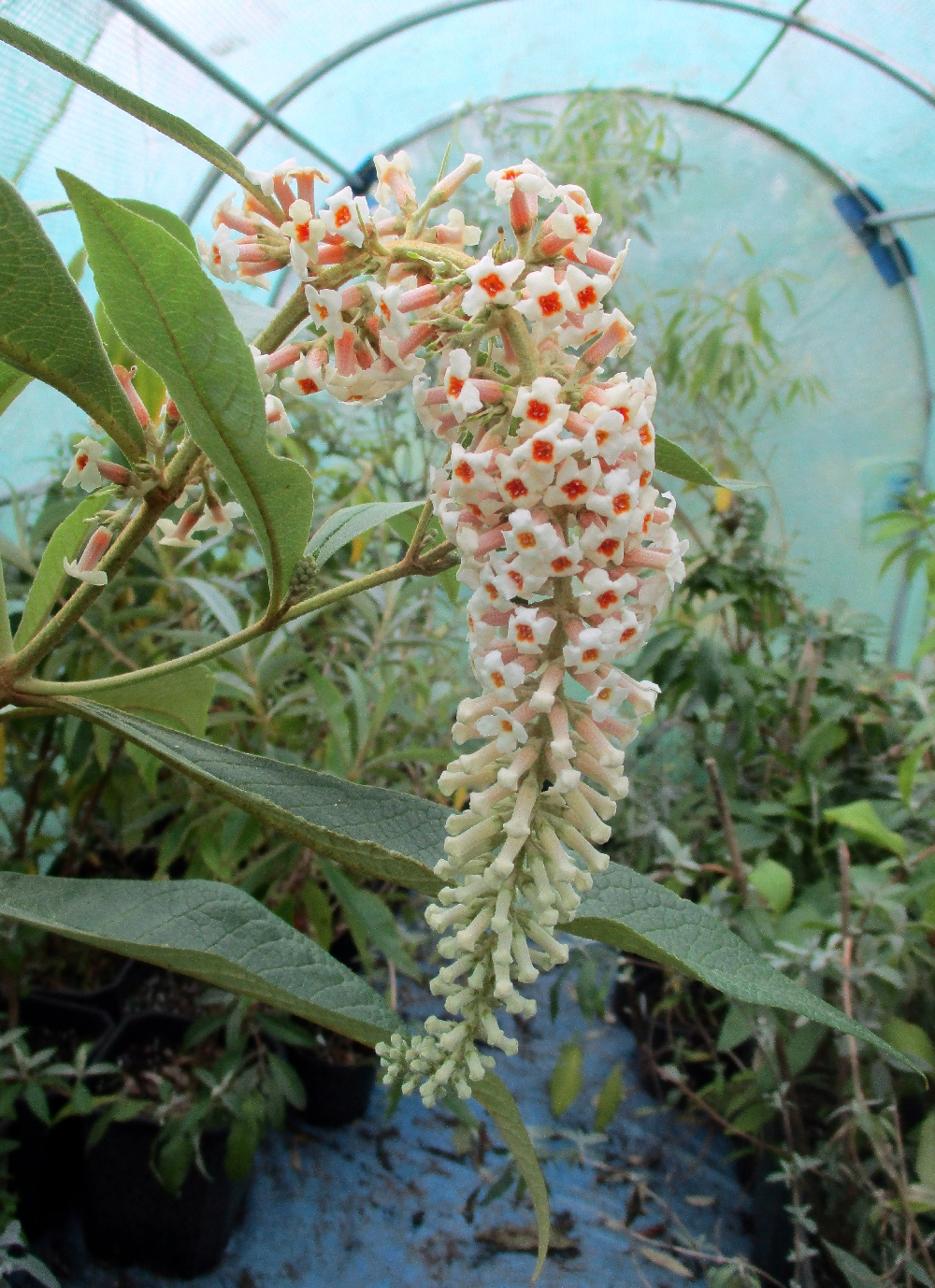
|
|
| |
Buddleja limitanea, a synonym of B. forrestiiPosted 11th October 2020There are several Buddleja species that will keep flowering from early summer until the first frosts. B. limitanea, which is a form of B. forrestii and strictly speaking should be labelled as such, is one that will flower sporadically anytime from late May to November. I am growing several different collections with flowers varying from purple to almost white, but are otherwise virtually identical. The plant shown upper left came to me incorrectly labelled as Buddleja delavayi, although it is rather obviously a B. forrestii of the limitanea type. B. delavayi is actually a spring flowering Buddleja and a synonym of B. heliophila; I've mentioned before how common it is for Buddleja species to be either mis-identified or mislabelled. Anyway, this particular plant has larger flowers than average, which are mauve in bud and almost white soon after opening. The foliage is pale green and I suspect it to be a little more tender than others of the same type. Typical of B. forrestii is the short, wide and flaring corolla tube, with the stamens in the upper third. For comparison, the lower photo is another of the same species type - BO 14-138, from seed collected on the Cangshan above Dali, Yunnan. A delicate pink and with individual flowers a touch smaller, the identity with the first plant is clearly apparent. I have other collections from the same location: W/O 8046, with uniform mauve flowers; and ACE 2522, also mauve, which tends to fade to a pale lilac. It's a bind growing several examples of the same type, and most gardens or arboretums will keep only a single specimen of each species. I personally feel it is important to maintain a diverse gene-pool and preserve the infra-species variation ex situ. | |
|
| |
Buddleja pterocaulisPosted 10th October 2020I've been growing this plant for a couple of years now, and have yet to see it flower. Labelled as Buddleja pterocaulis lomgifolia, which is rather confusing. Going back to the Journal of Botany in 1935, I found out more about its origins and its enigmatic, but completely erroneous, name. B. longifolia is actually a South American species, and the name was accidetally duplicated by Gagnepain and this error corrected by Jackson by renaming the specimen B. pterocaulis, a reference to the winged stems. Subsequently, in 1979, B. pterocaulis was reduced to a synonym of B. forrestii by Leeuwenberg; in other words, this plant is an example of B. forrestii, and not a discrete species. The leaves are long, but not significantly longer than some other B. forrestii plants, and the branchlets aren't as conspicuously winged as some other members of this species. Intriguingly, the leaves, stems and buds are covered in a soft white tomentum to an extent unusual in B. forrestii, a feature more common in B. macrostachya. However, without flowers to examine and no sign of any forming soon, I can't make a positive identification which of the two it is, although the overall appearance strongly indicates it is one or the other. I've recently started giving it excess potash (potassium sulphate) in the hope that, even if I cannot get it flower now, it will be sufficiently well fed to bloom next year. | |
|
| |
Unnamed HybridPosted 20th September 2020I raised this hybrid back in 2011 and, by planting it behind a bigger more vigorous sibling, forgot just how pretty the flowers can be. This time of year the lavender fades, revealing a delicate yellow colour underneath. I now have a new plant to put where I can actually see it. If it does well, I'll have to find it a name. | |
|
| |
Buddleja Butterfly GoldPosted 20th August 2020Both Florence (syn.:Variegata) and Burncross have variegated foliage with cream-white margins and pale violet flowers. Both can be disppointing in a real garden situation. I am hoping the new Butterfly Gold, available from Thompson & Morgan, will prove a better doer. I picked one up recently and it does look more robust than the competition. In the garden centre, the flowers on various plants looked subtly different shades and I chose the one with the darkest, almost blue, flowers. I suspect the variation in colour was only an artifact of its growing conditions and they will be the normal violet next year. | |
|
| |
Buddleja myriantha W/O 8047Posted 13th August 2020The name Buddleja myriantha is egregiously misapplied in the horticultural trade, either to a form of B. curviflora or to the blue form of B.salviifolia. Last year I tracked down an authentic B. myriantha (H&M 1520), collected from the Cangshan (Yunnan, China). And now I have another one. W/O 8047 is a seed-collection also from the Cangshan in Yunnan, collected by Chinese Alpines at an elevation of 2200 metres. The seedlings were a nightmare to grow: very leggy and lax, and slow to mature. I persevered and they over-wintered surprisingly well. Finally a couple are flowering, and the photo shows the most robust plant. I can, with some confidence, identify the plant as B. myriantha as it matches both the description and illustration in Flora of China. The individual flowers are tiny; the species gains its name from the huge number of these diminutive flowers in each long and triple panicle. This example is a pinky colour rather than purple, a colour common in the similar species B. albiflora. B. myriantha can be distinguished from B. albiflora as follows: B. albiflora has rounded or subterete stems, whereas B. myriantha has noticeably four-angled stems; the calyx and exterior of the corolla tube are smooth in B. albiflora, but in B.myriantha the calyx and outside of the corolla tube are distinctly tomentose (hairy), as can be seen in the lower photo. | |
|
| |
Just How Dark Can You Get?Posted 26th July 2020The cultivars of Buddleja davidii come in a remarkable range of the colours; whereas the wild plants are usually pastel shades like lilac and lavender, mutation and selective breeding has given us some very intense hues - blues, purples, magentas and pinks. The two darkest, to my eyes at least, are the ever-popular Black Knight and the recently introduced Buzz Indigo (syn. Midnight) from Thompson and Morgan. There is the potential to go even darker. This seedling, a second generation plant bred from one of my own seedlings, appears almost black from distance, resolving into a very deep purple up close. It's a fine upright plant with a well-branched habit, and not too vigorous: unpruned, it has remained at about two metres in height. Buddleja seedlings actually take a few years to mature and show their true colours (pun intended), so I'll have to give it another year to be certain it's a worthwhile addition to the Buddleja canon. Then I'll have to think up a name for it. | |
|
| |
Buddleja fallowiana F1 HybridPosted 24th July 2020A second round of Buddleja fallowiana X Buddleja davidii hybrids using the 'Alba' form crossed with alternative deep blue B. davidii cultivars gave me plants a little different from the first, and this one is my pick of the bunch. An intense sapphire blue and retaining the unusual eye and petal shape of the parent, the compromise is that the foliage is not particularly grey or felted. Its siblings are not bad either: half of them are violet-mauve rather than blue and those I've kept have the grey foliage. I'm waiting on other similar hybrids to flower and, if I get a suitable seedling with a good colour and B. fallowiana type foliage, I'll certainly try another F2 generation using this cultivar. | |
|
| |
Buddleja fallowiana F2 HybridPosted 23rd July 2020Buddleja fallowiana is a fine species, but is a little more temperamental than B. davidii. The challenge is to breed a plant that has the same soft, felty foliage with a more robust constitution. Culitvars like Lochinch and Westhill are B. fallowiama hybrids; neither is particularly striking. My first round of hybrids used the 'Alba' form crossed with deep blue B. davidii and I've a few plants that are quite nice. This plant is an F2, accidentally created by crossing two F1 hybrids. The colour is pale, and mostly confined to the edge of the petals. The foliage is pale and glaucous, and the habit looks restrained. It's quite unlike anything else I've seen. I'm trying again to create more of these hybrids, this time using both the white and coloured forms of B. fallowiana. Eventually, I hope to have deep, intense coloured flowers while retaiing the glaucous foliage B. fallowiama. | |
|
| |
Buddleja forrestii F1 HybridPosted 21st July 2020One of the Buddleja forrestii plants I grow is self-fertile, and the seedlings I've grown are mostly near-identical to the parent. One, though, is rather different with smaller foliage and a more compact growth habit. And it has finally flowered (left); the colour is the softest pink and the flowers quite delicate, although the panicle is the same form as the parent. I am assuming this is a hybrid, and I'm pretty sure the pollen came from Buddleja davidii, as the longer and cylindrical corolla tubes (see the lower photo) are unlike Buddleja forrestii. I've planted the seedling out and I'm hoping it will prove hardy and grow well, possibly being a little more restrained than the large and vigorous parent. Years ago, a B. forrestii X B. davidii hybrid called Buddleja X 'Hotblackiana' was listed, and it's believed to have died out. Based on the evidence of this new hybrid, I suspect that one of the plants I have always known as B. limitanea (a synonym of B. forrestii) is the long-lost 'Hotblackiana'. This atypical B. limitanea plant also has longer, cylindrical corolla tubes and the overall shape of the individual flowers is very similar to my new hybrid. All other specimens I've seen have short, wide and conical corolla tubes typical of all the different forms of B. forrestii, including the 'limitanea' type. The difference could well be evidence for its hybridity. Unfortunately, the trail has gone cold on this plant's origins, so this remains just a theory. | |
|
| |
Buddleja nivea X Buddleja forrestiiPosted 29th June 2020I've grown a few hybrids of the various B. forrestii and B. nivea cultivars. Mostly they resemble B. nivea, with furry foliage and rather small flowers. The parents of this one are B.nivea - pink form and a relatively restrained white-flowered B. forrestii. It's a bit of an exception in that the B. forrestii features are dominant. The foliage is not particularly hairy; the flowers show their B. nivea heritage only with the dense hairs in the mouth of the corolla tube. I've neglected it this spring, but I now think it's unusual enough to be worth persevering with. |
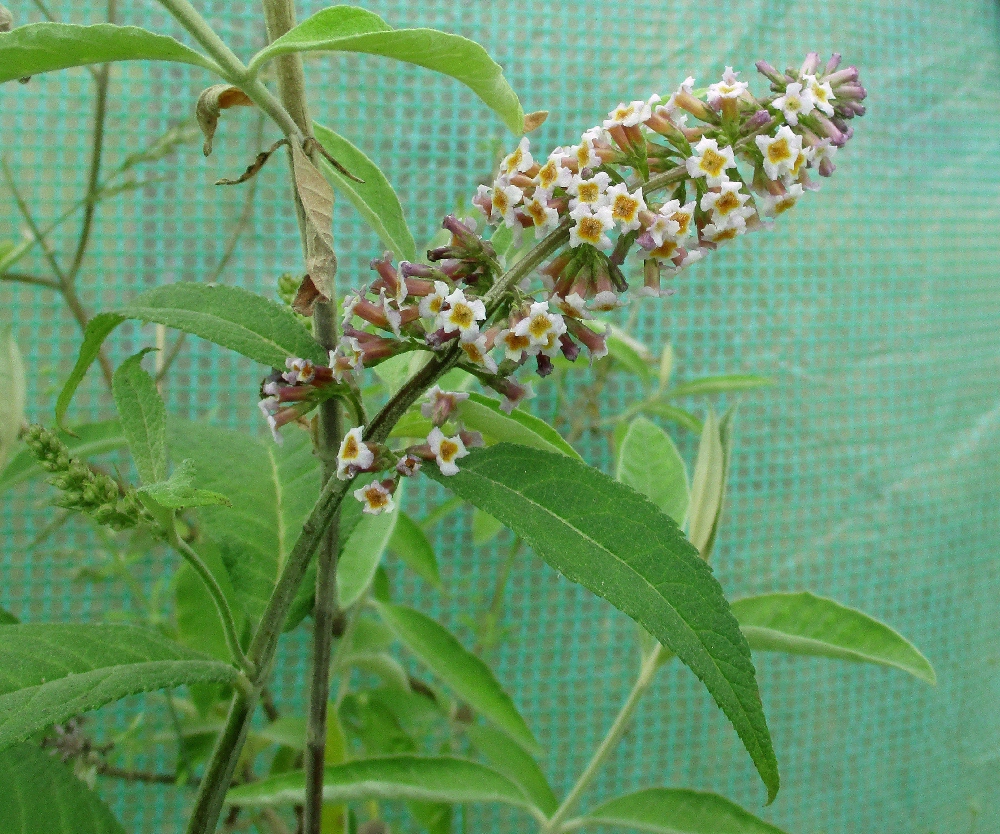
|
|
| |
Buddleja forrestii W/O 7061Posted 25th june 2020Two years since I planted the seeds, and it has finally flowered! Unequivocally Buddleja forrestii. The seeds were collected by Chinese Alpines from Longzhoushan, Sichuan, China, at an altitude of almost 3000 metres, so this should prove hardier than average for the species. I think it will form a large shrub once planted in the ground. It's another white flower, and so many available B. forrestii cultivars are white already. I'm still hoping to find the apocryphal maroon flowered specimen described in the old literature. | |
|
| |
Buddleja nivea var. yunnanensisPosted 8th june 2020Some things are earlier into flower this year, because of the warmer than usual spring weather, although B. nivea var. yunnanensis is always a month or so ahead of the other members of the species. And what a monster it is, looming up over my shed. Huge felty leaves and large panicles that promise much in bud, but are rather underwhelming when their tiny mauve-purple flowers open. | |
|
| |
Buddleja salviifoliaPosted 20th May 2020Buddleja salviifolia, the blue form, is flowering now, a couple weeks after the white 'Alba' type. This plant grows into a rather tall and ungainly shrub, but the flowers are sensational - large panicles of blue flowers with a perfume second to none, which can fil the garden with scent if the weather is warm. I've found it completely hardy and a reliable bloomer. In fact, pot-grown hothouse specimens are less inclined to flower profusely. This species hybridises with Buddleja crispa varieties quite readily, despite coming from different continents and being quite distantly related. I have a hybrid seedling growing, but it's yet to flower: maybe next year with a little luck? | |
|
| |
Buddleja salviifolia 'Alba'Posted 10th May 2020Now spring is in full flow several of the species Buddlejas are starting to flower. B. salviifolia is a variable species that grows across a large range in southern Africa. This is the white-flowered form, which has long pendulous leaves, and is proving hardy now it has reached good size. It always flowers several weeeks ahead of the more familiar blue-flowered type and crossing the two is proving difficult as they never seem to be open at the same time: it's gone over now just as the blue one starts opening. Lilac flowered examples are common in Africa, but I've not seen one in cultivation as yet. I have some seedlings growing from wild-collected seeds and I'm hoping these will be a pale lilac. The international exchange of wild plant material is becoming more restricted, what with the Nagoya Protocol and increasing phytosanitary regulations, and my seedlings will add to the ex situ gene pool of this species. | |
|
| |
New Variegated BuddlejaPosted 20th January 2020There have been quite a few new Buddlejas in the past few years, but here's one from Thompson and Morgan that's a little different. Butterfly Gold is a Buddleja davidii cultivar with cream-yellow and green variegated foliage. I saw small plants of this variety at last year's Horticultural Trades Association National Show, the foliage was quite striking. The flowers, which I didn't see, are reported to be a violet-purple. The ultimate size of the mature plant should be around 2 metres by 1.5 metres – a medium-sized shrub. Superficially, Butterfly Gold looks very similar to both Florence (syn.:Variegata) and Burncross, sharing the uninspiring flower colour and the variegation type, with all three having similar wide cream-coloured edges to the leaves. Florence has a poor spreading growth habit, becoming a rather lax and sparse shrub. Burncross is smaller and neater, with very pretty foliage, but its flower-panicles are short and it's also a nightmare to propagate – this latter feature could be why Burncross hasn't really caught on. Butterfly Gold certainly promises to improve on the older varieties, and the publicity photos suggest this cultivar is a denser, more robust plant. Time will tell whether or not this is in fact an improved variegated Buddleja. Photos coutesy of Thompson & Morgan. | |
|
| |
Buddleja alternifolia | |
Buddleja x intermedia | |
Buddleja japonica | |
Buddleja sessiliflora (as Buddleja verticillata) | |
| |

